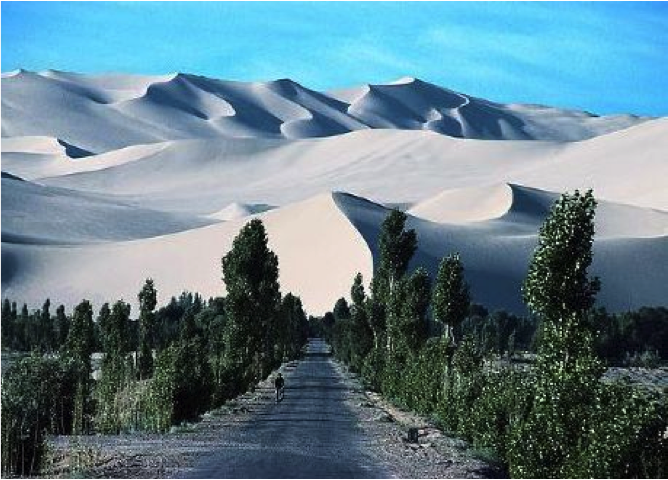The Great Green Wall of China
“The Great Wall of China is the only man-made structure visible from space.” How many times have we heard this phrase - in class, in the media, and on visits to China? The idea was first proposed by William Stukeley, an 18th century antiquarian dubbed the founder of the field of modern archaeology, in 1754. By the end of the 19th century, it had become an established fact that the Wall could actually be seen from the moon. Since man first made it to space in the mid-20th century, however, the claim has come under scrutiny more than once, and finally debunked (from normal orbit, one would require eight times normal vision to see the Wall, and 17,000 times normal vision to see it from the moon).
While the Great Wall may not be visible from outer space, the Chinese government has planned an ambitious reforestation program, the Great Green Wall of China – also known by its less charming name: the Three-North Shelterbelt Reforestation Program – that could rise to the challenge. First conceived by Deng Xiaoping in 1978, the Great Green Wall (GGW) aims to “afforest” 90 million hectares of land by 2050 in an attempt to stem the ominous advance of the Gobi desert.
Beginning after World War II, China underwent a rapid industrialization process that continues today. While it has lifted hundreds of millions out of poverty, and created the second most powerful economy in the world, the economic boom initiated environmental decline, most prominently major deforestation fed by a growing hunger for paper goods. The consequences proved dire: huge sandstorms, known to locals as “yellow dragons,” struck major cities in the north, including the capital city Beijing, large tracts of agricultural land were degraded, and little grassland remained to feed herds of sheep and cattle roaming the lands of inner Mongolia.
The GGW, part of a larger national effort to increase forestation, was a response to this environmental crisis. By 2009, the Chinese State Forestry Administration had succeeded in increasing forest cover from 12% to 18%, with the goal of reaching a national forest cover of 42% by 2050. On the surface, these numbers may seem admirable, mimicking a Depression-era Civilian Conservation Corps (CCC) that succeeded not just in providing unskilled worth for hundreds of thousands, but also in preserving vast tracts of degraded forest throughout the United States. A closer look, though, reveals deep problems, not least of which is agency transparency.
Throughout the GGW’s history, authorities responsible for the project have shown an unwillingness to be transparent. More recently, however, agency efforts have been more focused on increasing awareness on the issue, publishing data showing great environmental improvements across the country. Bureaucratic infighting has also presented an obstacle. As lately as 2005, Hans-Peter Paulenz of the German Technical Cooperation (GTZ), said:
“Bureaucratic infighting between the [State Forestry Administration] and the Three-North Shelterbelt Office, and difficulties in controlling operational factors affecting the baseline data recording by relevant local parties have made progress very slow.”
In addition to administrative difficulties, international environmental agencies have found many negative effects associated with the implementation of the Great Green Wall. For one, the trees, which are not even indigenous to China, have been planted in areas previously occupied by grassland. The water stress caused by their presence causes a drop in the water table, thus jeopardizing humans that depend on underground reserves for their livelihood, as well as other plants. Furthermore, monoculture plantations – vast areas planted with just one or two tree species – threaten land health. While they may provide economic benefits in the form of future reserves of timber and even food, according to Jianchu Xu, a professor at the Chinese Academy of Science and a senior scientist at the World Agroforestry Center, “Plantation monocultures harbor little biodiversity; they provide almost no habitat for the country’s many threatened forest species.” He added that any benefits, such as providing windbreaks and carbon storage, “come at a high cost to other ecological functions.”
In light of this criticism, the State Forestry Administration has spearheaded new projects that aim to regenerate degraded nature areas, most notably in Southwest China, where a partnership between the Chinese Center for Nature and Society and Conservation International aims to restore a region that includes diverse ecosystems. Other similar programs are springing up throughout China, the country with the most nature reserves in the world.
China, with its aspiring renewable energy projects, “green cities”, and reforestation efforts, has shown a willingness to combat climate change while not sacrificing economic growth. As the Western world’s financial dominance in global markets fades, developing countries, especially in sub-Saharan Africa, should look to China as an example of viable environmental and economic growth.


